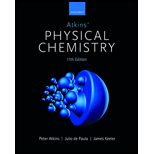
Interpretation:
The Huckel secular equations for
Concept introduction:
Delocalization of energy refers to the extra stabilization of the molecule which is due to allowing the electrons to spread over the entire molecule. To calculate the delocalization energy, the energy of the molecule in question is compared with a molecule in which electrons cannot spread over the molecule.
Answer to Problem 9E.1P
The Huckel secular equations for
The energies are expressed in the form of Coulomb integrals
The delocalization energy of
Explanation of Solution
In
Therefore, the secular determinant for the compound is of the order
The secular determinant for
The above determinant is solved as shown below.
The above equation is solved as shown below.
The value of energy obtained from above equation is given below.
The localization energy of
The determinant is solved to calculate the localization energy as shown below.
The roots of the quadratic equation in equation (1) are calculated as shown below.
The value of localization energy from equation (2) is given below.
The number of
Therefore, the formula to calculate the delocalization energy is given below.
Substitute the value of
The value of
Therefore, the approximations are applied to the equation as shown below.
Therefore, the equation for delocalization energy can be written as shown below.
Therefore, the delocalization energy of
Want to see more full solutions like this?
Chapter 9 Solutions
Atkins' Physical Chemistry
 ChemistryChemistryISBN:9781305957404Author:Steven S. Zumdahl, Susan A. Zumdahl, Donald J. DeCostePublisher:Cengage Learning
ChemistryChemistryISBN:9781305957404Author:Steven S. Zumdahl, Susan A. Zumdahl, Donald J. DeCostePublisher:Cengage Learning ChemistryChemistryISBN:9781259911156Author:Raymond Chang Dr., Jason Overby ProfessorPublisher:McGraw-Hill Education
ChemistryChemistryISBN:9781259911156Author:Raymond Chang Dr., Jason Overby ProfessorPublisher:McGraw-Hill Education Principles of Instrumental AnalysisChemistryISBN:9781305577213Author:Douglas A. Skoog, F. James Holler, Stanley R. CrouchPublisher:Cengage Learning
Principles of Instrumental AnalysisChemistryISBN:9781305577213Author:Douglas A. Skoog, F. James Holler, Stanley R. CrouchPublisher:Cengage Learning Organic ChemistryChemistryISBN:9780078021558Author:Janice Gorzynski Smith Dr.Publisher:McGraw-Hill Education
Organic ChemistryChemistryISBN:9780078021558Author:Janice Gorzynski Smith Dr.Publisher:McGraw-Hill Education Chemistry: Principles and ReactionsChemistryISBN:9781305079373Author:William L. Masterton, Cecile N. HurleyPublisher:Cengage Learning
Chemistry: Principles and ReactionsChemistryISBN:9781305079373Author:William L. Masterton, Cecile N. HurleyPublisher:Cengage Learning Elementary Principles of Chemical Processes, Bind...ChemistryISBN:9781118431221Author:Richard M. Felder, Ronald W. Rousseau, Lisa G. BullardPublisher:WILEY
Elementary Principles of Chemical Processes, Bind...ChemistryISBN:9781118431221Author:Richard M. Felder, Ronald W. Rousseau, Lisa G. BullardPublisher:WILEY





